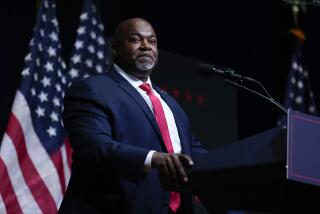From moose whacker to McCain’s meal ticket
- Share via
If you want to gauge just how integral Sarah Palin has become to John McCain’s hopes of winning the presidency, consider this: On Tuesday, when the Republican nominee went before the cameras to address what, at that moment, looked like financial Armageddon, he repeatedly referred to how much better off people would be under “a McCain-Palin administration.”
No major party candidate in living memory has campaigned under such a formulation, but McCain has his reasons. In electoral terms, Palin is McCain’s meal ticket. She is consistently drawing larger crowds than he does, though his numbers also have increased since the Alaska governor’s selection. And what can anyone call those knots of lipstick-waving women at her rallies except “Palinites”?
Perhaps more important, the vice presidential nominee is outstripping McCain in media coverage. Last week, according to the nonpartisan Pew Research Center’s weekly analysis of campaign journalism, Palin figured in 53% of all stories concerning the presidential race. McCain was mentioned in 49%. By way of comparison, Barack Obama came up in 61% of all the campaign coverage last week, while his running mate, Joe Biden, was mentioned just 5% of the time, despite a packed calendar of public appearances.
In an election cycle studded with the unexpected, Palin is a phenomenon whose outsized impact seems to rest on three factors.
The first is the culture of celebrity’s increasing penetration of our politics. Celebrity long has been the dominant force in much of our popular culture, but, up to now, it has touched our politics only glancingly. It should be noted that Obama also benefited from this trend early in his race against Hillary Rodham Clinton for the Democratic nomination.
Celebrities can be distinguished from candidates in a couple of ways. Candidates have a record to examine and a program to propose. Celebrities have a story to tell. In fact, a good story is the essence of celebrity.
Whatever your politics, both Obama and Palin have dynamite life stories -- different, but each compelling in its own way. It’s the infatuation with her life story that leads people inclined to admire her not to care when Palin repeatedly lies about her involvement with the so-called bridge to nowhere in her stump speeches. Nobody cares whether what she says about it is true, because it fits so neatly into her “story” -- moose whacker, “hockey mom,” PTA president-turned-governor, the common-sense reformer. (Anybody remember a movie called “Dave”?)
When the McCain campaign introduced Palin, it chose as the theme music the score from the 1993 film “Rudy,” a biographical movie about an undersized football player named Daniel “Rudy” Ruettiger who surmounted 27 rejections of his application to Notre Dame and actually made it onto the field as a player for the Fighting Irish. Somebody somewhere is calculating your subliminal susceptibility.
The second pillar of Palin’s appeal is her claim to represent and to speak for a Main Street America that resides somewhere “out there” in the small towns and the rural hinterlands. Demographically, of course, the majority of American voters now live in precincts deemed suburban. In fact, Palin’s Wasilla is considered by the census as a suburb of greater Anchorage, right down to the strip malls and big-box stores.
In any event, the suburbs are where most Americans have lived and cast their votes since the general election of 1992, when the traditional urban-rural divide exited our politics. Still, the notion of a simpler, more innocent small-town and farmstead America retains a powerful emotional appeal, particularly when it comes to economic issues.
At a time when so many Americans, their lives disrupted and distorted by the convolutions of the financial markets, are watching the little guys’ homes go into foreclosure while the Wall Street smart guys walk away with millions from the carnage they’ve created, there’s a great deal of angry nostalgia to be tapped.
Finally, there’s the fact that the religious right was spoiling to get into this election and was frustrated when McCain -- whom many of the movement’s leaders dislike and distrust -- sewed up the nomination. They’d virtually resigned themselves to sitting this one out until the Arizona senator reassured them on a key issue by striking this language from the party platform: “We invite all persons of good will, whether across the political aisle or within our party, to work together to reduce the incidence of abortion.”
Palin’s selection closed the deal. Never before has the evangelical right had one so clearly its own on a national ticket. George W. Bush talks the talk, but Palin, especially when it comes to style, walks the walk.
If you want to calculate the cumulative effect of these three factors, consider this: Since Palin was chosen, the number of McCain supporters who tell pollsters they are “enthusiastic” about the ticket has risen from 24% to 48%.
--
More to Read
Get the L.A. Times Politics newsletter
Deeply reported insights into legislation, politics and policy from Sacramento, Washington and beyond. In your inbox twice per week.
You may occasionally receive promotional content from the Los Angeles Times.








